Today In Aww: Dog And Baby
Warning: This picture of a dog and a baby will turn your testicles right into ovaries. If you already have ovaries you will probably grow another set. SERIOUSLY HOW FUCKING CUTE IS THIS DOG AND BABY PICTURE? OH MY GOD. [Via]
Quit Your Job! A Q&A with Dan Shanoff of Quickish (And His Wife Too)
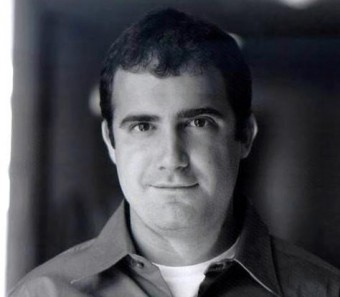
The Awl: Dan Shanoff! Not long ago, after some scheming, you left a job and started your own company and its first publication, Quickish, which is sports-oriented, and in beta, and provides immediate, quickly done news and views and updates. You plan to expand beyond sports in the future. Dan, why did you do this?
Dan: I have wanted to create my own company since I had my first job, where I was employee No. 1 for a couple of MBA drop-outs that got some seed funding from AOL to start a content site to keep AOL subscribers enthusiastic and engaged to be paying by the hour to be on AOL. It was 1995. The mandate was to try anything and everything, and I loved it.
Everything I have done since then — working for different start-ups and some more traditional companies — has been in this attempt to recapture that. I’ve helped build successful products, even a few from scratch. But this time, I wanted to put myself in the position of creating and testing the concept, working with partners to make it happen and ultimately launching and growing it with a team I build — where there was no corporate net.
So with that perspective going back to the first real inklings of the consumer web, I can say this: There has never been a better time to start a new company — particularly one focused on the consumer internet.
It doesn’t matter that I have limited (self-) funding. It doesn’t matter that I have two little kids and a mortgage. It doesn’t matter that my tech development background is nominal. It doesn’t matter that the competition is as ferocious as it has ever been.
“This was my now-or-never moment. I could already envision myself 5 or 10 or 20 years down the road regretting it, profoundly.”
What matters is two things, one external and one internal. Externally, technology and distribution and information got a lot more accessible, to the point where someone like me, with only a limited background in tech development or fundraising — could start a company.
But internally — and that’s where the motivation really has to come from — this was my now-or-never moment: I wanted to try to build my own company. If I didn’t, I could already envision myself 5 or 10 or 20 years down the road regretting it, profoundly. I had to try.
And here’s the best part: Despite the pressure and the uncertainty — like nothing I’ve ever felt, really — there isn’t a job in the world that I find more interesting or exciting (or harrowing) than the one I’m in the middle of now.
The Awl: You have an MBA, which is handy, so you’re not an editorial-only person who’ll be useless on the business side, but: why did you decide to launch without cofounders?
Dan: Fortunately, “Editor Dan” and “MBA Dan” have a pretty good relationship.
For some good reasons and bad ones, “solo founder” developed a bit of a stigma in the start-up community — particularly the oh-so-dreaded “non-technical solo founder.”
“You have to do what fits your business and your personality and your vision. And so that’s not to say that a great co-founder situation isn’t phenomenal. I just hope folks can see there are a couple of different ways to go.”
I get the theory: How can a solo founder without a technical background do what every start-up needs to do: “Ship.” Launch and build products.
By necessity, I think it needs to be a bit more nuanced than that, depending on your product, your experience and your network. If you’re trying to hack together a cool new app like GroupMe? You damn well better have a technical co-founder.
In the same way that start-up information has been made infinitely more efficient by the VC/entrepreneur media ecosystem; the start-up funding pipeline has been made infinitely more efficient by AngelList; the infrastructure systems have been made infinitely more efficient by Amazon or Rackspace; and the distribution system has been made infinitely more efficient by Facebook and Twitter…
…I think there is an opportunity for solo founders to bring together domain experts to help get products from idea to traction, at which point you’ll hit the milestone where the market — namely, investors and customers — indicate to you that your company can grow through bringing on more talent, whether that’s additional founders or just super-motivated employees.
For a content-focused company like mine, there was an intense focus on the initial product design and development. I was lucky enough to be able to work with Hard Candy Shell the best UX firm in the world; for those months of work, they felt (and still feel) entirely like my partners, even if that’s not the capital structure. And I was lucky enough to know the founder of Jolly Science, a start-up web and software development company that wanted to help me build and improve the products; again, everything about the relationship has felt like a partnership. I consider them every bit as much of a part of my team as any future co-founders or employees.
Both Hard Candy Shell and Jolly Science were professionally and personally invested in my company’s success (and I’m not talking about equity, but their sense of commitment to making it succeed) — that gave me the confidence to proceed as a solo founder, and I think the product is as good as it could have been, arguably because I focused on working with specialized partners.
Again, I see this as very specific to me, with this company, my resources, etc. You have to do what fits your business and your personality and your vision. And so that’s not to say that a great co-founder situation isn’t phenomenal. I just hope folks can see there are a couple of different ways to go. Part of what makes this such a great time to start a company is precisely because there are so many partners out there you can come together with to help you build a great business.
The Awl: One thing that’s unusual about what you’re building as an editorial product is that it’s both somewhat distributed (as in, the front page is fairly similar to its Twitter feed!) and it’s very outward-bound. You skim; you click, you’re off, presumably to return sometime. This is a great service to news consumers! But it’s not exactly dreamy in terms of traditional business metrics, like “time on site” or sheer pageviews or what have you. How do you plan to deal with the challenges of running a publication that’s better for readers but maybe less-good for the MBA Dan?
Dan: Let’s back up: By design, I want the minimum level of engagement for the maximum number of people.
“It’s when you start to get greedy with people’s time that you start to get sloppy — traffic-trolling, gimmicks, tricks, gaming, absurd pagination.”
I’m not going to tell another publisher — or marketer — what their minimum level should be. But Quickish is designed to be low-commitment/high-reward, to give you a satisfying experience very quickly. You can come back once a day for 30 seconds or you can come back 40 times a day or you can come back when news breaks or during a live event knowing you’re going to have a valuable experience worth whatever time you’re willing to spend. But, at its core, as a product developer, you’ve got to know what your minimum satisfying experience is and build for that, layering everything else on top.
I maintain a focus on the minimum, because it’s when you start to get greedy with people’s time that you start to get sloppy — traffic-trolling, gimmicks, tricks, gaming, absurd pagination. And that’s just not sustainable. Eventually, people will get tired of the way you disrespect their time.
Even before the iPhone, the trend has been veering toward an “app-ified” media experience, whether or not you’re on a phone: A simple, elegant, valuable function — part of a system of simple, cool, elegant functions. Sometimes they interconnect — see Facebook or Twitter or Foursquare — but people seem to have a pretty elastic appetite for stuff that satisfies them. It’s mis-reading the era to think of engaging consumers as zero-sum, rather than trying to get a critical mass of people to make you part of their rotation, however long they might want to give you.
And so we’re focused on creating as few barriers to consumption as possible. Depending on your company’s goals, of course, getting some pre-determined level of vanity metrics can take your focus off the more important metrics. In the case of Quickish, we just want you to show up every day, for as long as you want to be there.
If their next click is to a great piece of analysis that Quickish is recommending, that’s phenomenal. Why? Because it sure as hell beats the “back” button; that next click, in and of itself, is an amazing piece of engagement; that it isn’t to a piece of Quickish content doesn’t matter in the larger fit. Because every time we send you to something great, the hope is that you’ll reward us by coming back again tomorrow for another recommendation or two (or two-dozen). Or reward us by passing something along from Quickish via Facebook or Twitter. Or reward us by just telling a friend or two you found a great new site.
At some point, that credibility reaches a scale where it fits with a marketer’s plan to reach an engaged audience. Or that credibility reaches a scale where you can pass along deals to users that they appreciate. Or that credibility reaches a scale where people are willing to pay a nominal bit for a specialized version of the product. Not even two months in, we’re on our way.
My company happens to be in a faux-luxurious position right now — “pre-revenue.” It’s an open question what business model works, and that’s OK (for now). We intentionally have multiple streams in development. But I feel really good about positioning the company’s fit for people’s behavior and interests that are evolving, rather than the ones that represent the conventional wisdom of even a few years ago.
The Awl Yes, you started-up a start-up whose revenues streams are “in development,” as is so often the thing to do these days. This is betting big on a long dream! Can you put your delightful spouse Margery, or one of your many dozens of delightful children, on the line here to explain how you made this choice as a household entity?
Dan: Margery says:
“It didn’t feel like a risk, because it’s a great idea and I believe in Dan.
“Well, let’s be fair: Everything is a risk. But to me, I would rather this kind of risk — a great idea backed by really smart business thinking and a ton of passion — than a job he doesn’t love with an established company, which is probably just as risky.
“So the big considerations were: (1) Can we afford it? (Yes, but certainly his ‘founder’s salary’ of zero isn’t a long-term solution.) (2) How does it impact the kids? (I work full time, too, so we have had to use baby-sitters a lot more, in addition to their regular daycare.) and (3) Can we account for the early strain on our relationship? (And, so far, we have, by recognizing that this first year after launching will mean that the dishwasher just gets emptied less often.)
“So far it’s been great. I can’t wait to see where it goes!”
And, later, 4-year-old Gabe sees me with my laptop open on the couch pipes up with his opinion: “Daddy, what are you working on? Qwwwwwickishhhhh?” There’s a lot of that. Hey: Another opportunity to keep refining the company pitch to a captive audience.
Sponsored posts are purely editorial content that we are pleased to have presented by a participating sponsor, in this case Dockers; advertisers do not produce the content.
Dead Man Really Hated President, American Cancer Society
“In lieu of flowers, at Jim’s request, please make a donation to ANYONE running against Barack Hussein Obama, or the American Cancer Society.” [Via]
Rap Music Is Good Now Because Rappers Aren't Afraid To Be Weird
Proclamations that a certain era is “good” or “bad” for music are always specious. There’s both good and bad music being made all the time, of course, in all different genres, and that’s been true even during eras accepted as either “golden” or “dead” for whatever style you might be talking about. What’s easier to talk about, what I think people are actually assessing when they talk in this way, is what’s popular at a certain time in history — stylistic characteristics of the music that happens to be selling the most, or being played on popular radio stations. Of course, people often disagree about stylistic characteristics, too, whether they make for good or bad music. Different ears hear differently. Even among people as susceptible to group-think as music critics — who all proclaimed, every single last one of them, that Kanye West’s My Beautiful Dark Twisted Fantasy was a straight-A, five-star, 10.0 masterpiece and the undisputed, inarguable, scientifically proven 100 percent guaranteed best album of 2010, objectively speaking.
That said, objectively speaking, this, right now, is a really good time for rap music. What’s popular, I mean. Except Drake.
Kanye’s album probably has something to do with it. It was a work of great artistic ambition, and the fact that it succeeded as it did was bound to have a positive effect. More than Kanye, though, I’d give credit to Lil Wayne and Gucci Mane for leading the way to a point where, as G from the underground-championing site Grand Good put it:
“We should celebrate the fact that Jay Electronica and Tyler, The Creator can comfortably co-exist in that misty plane of rap popularity. And our freedom to consume and process and react to both, the adult and the child, without feeling compromised. Or something like that.”
Jay Electronica is the deep-thinking New Orleans rapper who Jay-Z signed to his Roc Nation label in November. He’s older for an up-and-comer, 34, and has been working for years below the mainstream radar. And you probably read about Tyler the Creator recently. (He’s the 19-year-old member of the L.A. collective Odd Future, who made a huge splash with their performance on Jimmy Fallon’s show two weeks ago.) They’re both really good. What’s more important, they’re both proudly, defiantly, weird.
Here’s another Odd Future video, this one for a song rapped by Tyler’s colleague Earl Sweatshirt. It’s excellent, but a warning: this video has lots of blood and gore. I find some of it extremely unpleasant to watch. You may want to close your eyes. (But keep listening while you do. The song is dynamite.)
Also very weird, and also getting a great deal of mainstream attention lately, is Berkeley, California’s Lil B. A member of the Bay Area group The Pack, and the progenitor of a largely spontaneous style of rap (a style of being, really) he calls “based,” Lil B is quite unlike anything hip-hop has ever seen before. (Though he is reminiscent, especially in his cold, nasally voice, of Oakland forefather Too Short.) Lil B calls himself “Based God,” films videos in churches, and compares himself to Jesus, Ellen DeGeneres and Justin Beiber.
He also calls himself a “nerd” and a “faggot,” though he says he’s heterosexual. The faggot part is really, really different and new for rap. And, one would hope, might actually lead to a time when there could be a popular rap artist who was openly gay. Lil B is nothing if not interesting.
It’s particularly interesting to see him working with Tony Yayo. Yayo is a member of 50 Cent’s G-Unit, a brawny, unforgiving crew that in many ways represents the strictest sort of conservatism and conformity in rap. Which is very much mainstream rap. Rap is one of the most conservative forms of popular music going. Generally, rap artists break codes of dress, behavior and subject matter at the peril of their commercial viability. This is incredibly self-defeating. How ridiculous is it that Jay-Z needs to worry about what shoes he wears when he’s on vacation, because someone’s going to see a picture of him and use it to score points in a diss song? How many free-thinking MCs have shied away from rhyming about “that crazy space shit that don’t even make no sense,” because someone else might not like it and punch them in their face “just for living”? (Some of this can be chalked up to the hyper-competiveness which also serves to make rap as vital and compelling as it is. So you take the bad with the good, I guess. It also speaks to the way that non-music aspects of a rap artist’s life can affect the reception of the music — in this way, I think, rap was prescient of the 24-hour-news, reality-TV-style of 21st century entertainment culture in general. But that’s a different essay.) Even an artist as brilliant and beloved as OutKast’s Andre 3000 has had to strain against voices questioning his realness or his manhood — those who would punish him for expressing his individuality. It’s depressing to think about what the world might have missed out on had his partner Big Boi’s more traditional rap style not provided a sort of street anchor for Andre’s artistic ambitions.
Which is not to impugn Big Boi’s own creativity or sense of adventure — he put his capital to great use a few years ago when he wrote and produced a ballet. And he’s like the world’s biggest Kate Bush fan. But in the OutKast schemata, he’s the cool guy. As opposed to the freak. And that, the cool guy, is by far the dominant persona adopted by rap artists. Machismo is so important in rap, vulnerability so taboo. Most of the music’s stars have held themselves like masters of their domains. Think of LL Cool J, Snoop Dogg, Jay-Z, Master P, 50 Cent. The kings of rap act like the most popular kids in the school. The prom kings, the bullies, not the bullied, not the nerds. Misfits, for the most part, have had a hard time in rap.
There have been important exceptions, to be sure: Biz Markie, Flavor Flav, De La Soul. The Pharcyde, Wu-Tang, Kool Keith.
“I’m crazy” is a common attitude to cop in rap, but only in terms of “I don’t give a fuck.” Not in terms of “I am unhinged from reality.” Even someone like Eminem, for all his enthusiastic exploitation of shock and exposure of childhood psychological damage, has never really let himself look out of control in public. If anything, he’s always seemed coiled more tightly. As passionate as he is about his art, he has always kept a certain cool. And thus, kept himself more in line with standard rap behavior.
Again, there have been important exceptions.
Tyler the Creator eating cockroaches in his videos and rapping about dancing around his house in a pair of pink panties pays Ol’ Dirty Bastard a appropriately terrific posthumous tribute.
But really, I think the roots of the freedom of expression flourishing in today’s rap can be found in the way Lil Wayne shot to superstardom five years ago. (Popdust’s Christopher Wiengarten made this point in a nice piece last week — though I actually don’t so much hear the similarities between Tyler’s “Yonkers” and Wayne’s “I Hate Love” that Weingarten does. Different ears hear differently.) Wayne has been famous since the late ’90s, when he was a teenaged member of Cash Money Records’ troupe, the Hot Boys — a situation in which he played second fiddle to his cohorts Juvenile and B.G. Around 2005, though, Wayne enjoyed an explosion in artistry of a sort very rare in rap or any other genre. Suddenly, a rapper respected for his flow and charisma, but not previously known for elevated lyricism, was doing things with words we’d never heard before, and being rewarded and revered for it. And in the South — a region so long maligned as lacking great lyrical ambition and talent. Best of all, his technical blossoming was accompanied by that of a wild and charming (and, okay, openly drug-fueled) personality; a distinct and refreshing willingness to be different, nonsensical, silly — to be a weirdo. “We are not the same,” he said to listeners, fans, rival rappers. “I am a Martian.”
Wayne turned himself into the biggest star in rap by letting his freak flag fly. And this was very healthy for the music. In the past couple years, folks like Gucci Mane and Waka Flocka Flame have followed suit, with their own quirky takes on the mien.
Again, I think its great. And that rap music as a whole is very much the better for it. Everybody should get ice-cream cones tattooed on their faces. Metaphorically, I mean. Just that, everyone should have their own different flavor.
Testify, Fetus, Testify!
This witness will clearly be the smartest thing in the room: “A fetus has been scheduled as a legislative witness in Ohio on a unique bill that proposes outlawing abortions after the first heartbeat can be medically detected.” [Via]
From the Capitol Dome: Media Malpractice in Madison
by Abe Sauer

The Capitol in Madison has become Kafkaesque. On Sunday, an order that the building be cleared by 4 p.m. brought hundreds (maybe thousands) flooding into the dome in the afternoon. A good many of these protesters had taken the measure that identified them as prepared to be arrested: ACLU’s phone number written on a body part, in ink.
But then, nothing happened. The night passed. Some were lulled into believing the order had come and gone, and left in the morning, confident they would be allowed entry later. This included Teaching Assistants’ Association co-head Kevin Gibbons, with whom we spoke last week.
Suckers.
Capitol officials have created a bit of a paradoxical disaster for themselves. After failing to enforce the clear-out order Sunday night, the doors were locked Monday morning. This is in all likelihood a direct violation of the state constitution. The authorities would have been more within the rule of the law to arrest 800 people Sunday night than to lock out 200 people Monday morning. But the doors remained locked all day. Defending Wisconsin has already filed a lawsuit.
Rumors of barricades have been greatly exaggerated, with one flimsy Photo-with-Mall-Santa nylon strap extended on one side of the crowd, ostensibly to create a space for staffers to enter. It is ignored by everyone. The mix of protesters and sheriff’s deputies and Madison police at the doors remains extremely civil, with many standing on the steps next to the officers and leading chants, speeches, what have you.
During the day, when most people are at work, the crowd is more heavily made up of students and a certain strain of “professional” Madison protester. But after about 4 p.m., it swells by hundreds, with teachers, trades workers, cops and other supporters.
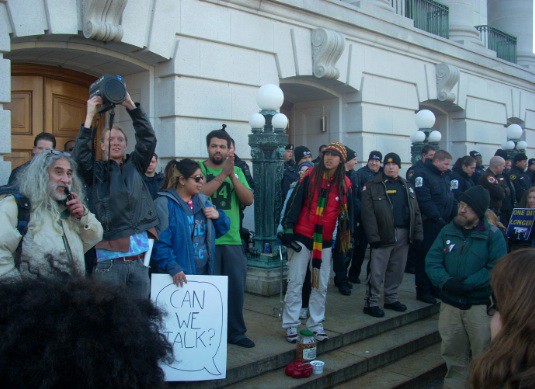
If anything, the police don’t know anything more than the protesters do. Yesterday, Monday afternoon, I was told that I needed Monday’s press credential pass (color coded by day) to enter the capitol. When I asked where to get those credentials, the officer told me to go to room 235 Southwest. I asked the Ozaukee County deputy if he saw the ridiculousness of that process and he nodded his head: “Yeah. It doesn’t make any sense.” When I asked him who he’s getting orders from, he said he wasn’t sure. He thought it’s maybe the University of Wisconsin police, but it might also be the Capitol Police. Needless to say, he doesn’t know who’s in charge and he doesn’t actually know the rules for letting people in and out, except that I’m certainly not allowed in without the proper credentials. “What to do just comes over the radio,” he said.
Looking for another entrance, I ran into Jonathan Grieser, rector of the capitol square’s Grace Episcopal Church. His face was awfully ruddy, making him look especially… rectorish. Father Grieser, in Madison just since 2009, described the political climate as “much different than I was used to.” He said that the church has been open to all protesters and on Saturday was jammed with at least 500 who came to pray and receive warmth. Of the goings-on, he said he is sympathetic and that “scripture is clear on the rights of human beings to a livelihood. It’s clear God is on the side of the oppressed and poor.” He added:”It is my responsibility to remind everyone of that.” A young woman came and introduced herself to Grieser; she was from the Interfaith Worker Justice advocacy group.

At the other side of the building, I met Dominic, a member of IATSE, the union of professional stagehands, motion picture technicians and allied crafts. He has been out here almost every day for two weeks. I asked if he saw the union shout-out during the Oscars on Sunday night. “No,” he said. “I was working.”
Yesterday, Larry Meade, human hot air machine and husband of UW-Madison law professor and pundit Ann Althouse (the Midwest’s Michelle Malkin), posted a video in which he accused the police department of a conspiracy and lambasted the current media organization landscape. In the video (which, in bizarro world, is shown every hour on Fox News), Meade gets in the face of the police and demands entry, claiming he isn’t media: “I’m private media.”
The irony of denying Althouse’s husband access to the capitol without official media credentials is that the credentialed media has done a pathetic job of covering the events. Outside Wisconsin’s own official news organs, the nationals’ approach to covering the protests borders on malpractice. When Paul Krugman is bothered to get into the Times CMS to post “a blog” comparing the job you’ve done in Wisconsin to the one you did in the buildup to the Iraq War, well, you’ve done a pretty bad job.
If the events in Wisconsin prove one thing, it is that the mainstream media has become journalistically irrelevant when it comes to national issues and coverage. Broadcast media is incapable of explaining anything outside a macropatriotic framework and has proven allergic to anything that puts off even the slightest whiff of the class warfare that scares away big-market advertorial. Meanwhile, the other side is cable news’ partisan echo chamber of regurgitated self-assurance, where no blow is too low and no fact needs sourcing before being leveraged to make a prearranged point. Cable news reporting on Wisconsin is like going to a whorehouse and then bragging to your buddies about this girl you seduced.
One illustration of the heretofore respectable mainstream press’ complete abdication of its responsibility is The New York Times. While the Times has covered the protests, it has not done so with anything nearing its abilities.
On February 22, the Times ran a story: “Union Bonds in Wisconsin Begin to Fray.” The front-page piece was written by none other than A. G. Sulzberger himself, who managed to ask his driver to check the GPS to discern that his byline should be “Janesville.” The piece was so favorable to Walker that the Governor himself a day later said to a man he believed to be David Koch, “I don’t normally tell people to read the New York Times. But the front page of The New York Times has a great story… one of these unbelievable moments of true journalism… objective journalism.” This is the same Scott Walker who, in two successive days, Tweeted links to reporting done by a 22-year-old at the Heritage Foundation, which he assessed as “Gr8.”
But the frustrating part isn’t that the Times is having a Sulzberger take out an anti-union grudge under the guise of journalism.
The pathetic part is that the Times has one of the nation’s best labor issues reporters actually in Madison and it’s sending him to file reports like “Delivering Moral Support in a Steady Stream of Pizzas.” The author, Steven Greenhouse, is an authority on labor and worker rights and author of The Big Squeeze: Tough Times for the American Worker and “World of Hurt,” a deep investigation into New York’s workers’ compensation system, which won an award for The New York Times. I ran into Greenhouse last week while he was writing that pizza story.
Greenhouse’s presence in Wisconsin raises one interesting question about Sulzberger’s recent byline. In the “Unions Fray” piece, it’s Sulzberger’s reporting from Janesville’s GM plant that required a later correction, noting that “While the man, Rich Hahn (not Hahan) described himself to a reporter as a ‘union guy,’ he now says that he has worked at unionized factories, but was not himself a union member.” But more curious is the fact that, just a year ago, Greenhouse wrote a long and excellent investigation of Janesville’s GM plant for Granta (“Janesville, Wisconsin”). In it, Greenhouse looked at the the plant closure, the unions, and all the factors at play. So why send Sulzberger out to find interview subjects in a place where Greenhouse already had deep and relevant connections?
Yesterday, I personally got to see the media’s negligence in action, as a CNN crew ignored a large solidarity protest of police officers to instead wander to the edge of another small gathering and shoot from a distance. At about 5 p.m., a long line of protesters carrying “Deputies for Democracy” and “Cops for Labor” signs loudly made its way around the capitol. The CNN news crew literally did not even acknowledge the demonstrators as they marched past, American flag and all.
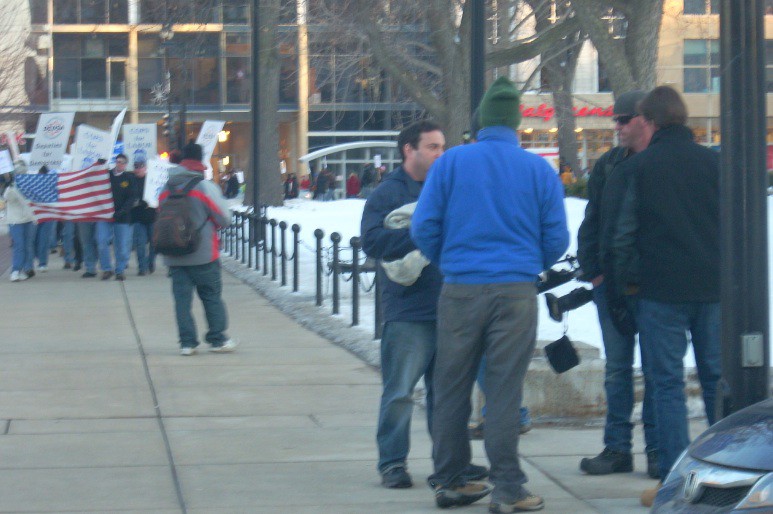
About 20 minutes later, the CNN crew meandered up toward the police line where a small group of protesters were peacefully facing the police guarding the doors. The CNN crew set up 25 feet away and shot, at best, three minutes of video, and then turned around and went back to their trucks, 200 yards away across the street, by all the other media trucks.
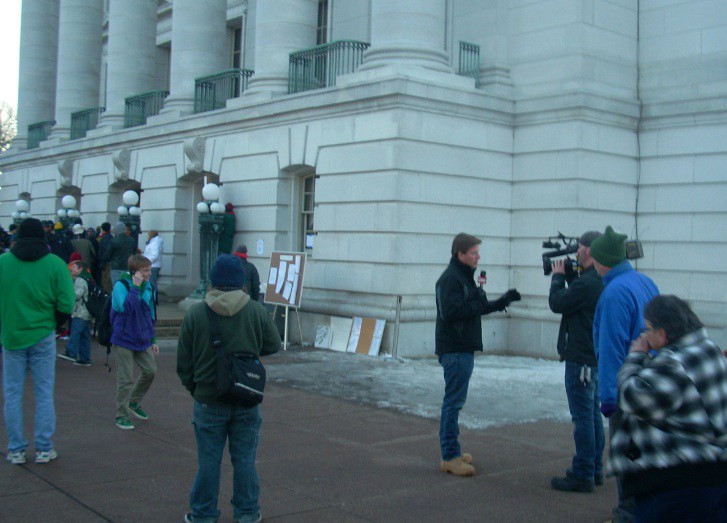
Later that night, CNN’s Anderson Cooper spent his time covering Charlie Sheen.
Walker will give his budget address today. The speech comes as the Republican leadership begins to tighten the screws on the protesters and anyone else that refuses to go along with this bill. Yesterday, Senate majority Leader Scott Fitzgerald sent out a memo declaring that not only would timesheets of any employee of a missing senator now need to be personally approved by him, but that “all copy machines access codes shall be deactivated for any Senator who is absent….”
Also, Republican Senators Lazich and Honadel introduced legislation to make prank phone calls illegal.
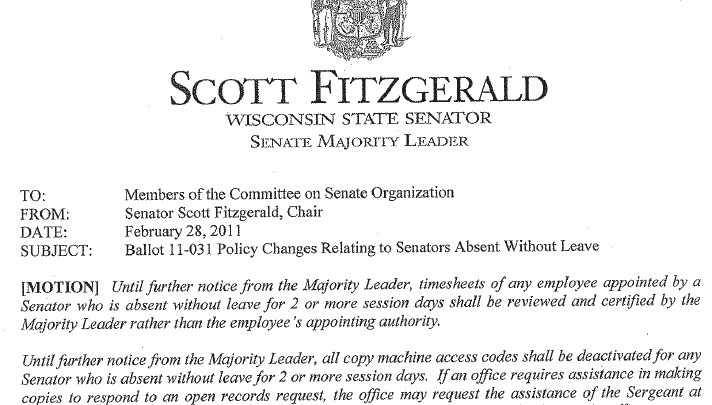
This is how this fight is more of less going to go from here on. The philosophical battle will still be represented by the occupation of the capitol, but the war will be won through a pitched battle of administrative memos, issue media, push polling and FOIA requests. I’ve already filed a few of those last myself. It’s going to be ugly. For instance, Sunday evening, protesters rallied when rumors circulated that moderate Republican Dave Schultz would vote against the bill. A more sober Monday saw Schultz possibly blackmailed back into voting yes.
Monday night, only about 100 to 130 demonstrators remained in the dome. Musician Jeff Burkhart was one, tweeting that he was inspired by a 60-year-old named Mildred who “decided to stay the night without a ride home, on a yoga mat.” Burkhart celebrated with bedding given him by the TAA.
One of those TAA members is Ashley Anderson, who told me around 11 p.m. that the dome was “mellow,” consisting of ISO members, some teachers from AFT, and then SEIU and AFSCME people. She added, “everyone is in the rotunda ground floor. The police are standing around really restricting other areas. And, yes, people are staying the night. They are quite determined. Most of the people here were the people who were ready to get arrested last night.” She then had a sleeping bag race around the rotunda. Anderson says that those who want to know what’s going on should follow her on Twitter.
She sent us a photo.

The freezing overnight temperatures did not keep everyone away. Tens of protesters hunkered down and spent the night on the concrete in temperatures that dipped down to 15 degrees.
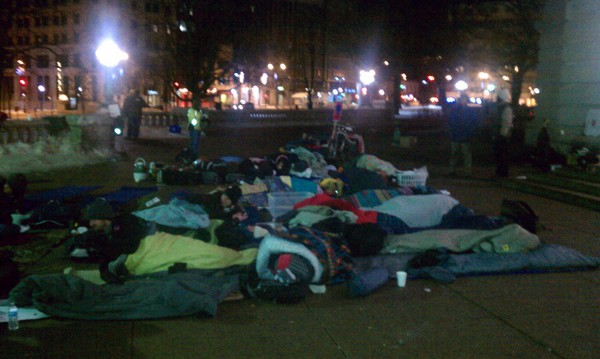
By morning, the Capitol was again allowing in a limited number of people, according to some kind of a one-out one-in policy. The governor’s budget address is today at 4 p.m. CST, and nobody is yet sure who will be allowed in and who will not. But while the public is kept out there is one group that is certainly still being allowed in: Lobbyists.
Then, late this morning, Judge Daniel Moeser issued a restraining order forcing open the capitol for the time being.
For reliable coverage of goings-on, follow the #wiunion Twitter tag. For more focused reports, the Isthmus’s Daily Page feed and WisPolitics are both robust without being totally overwhelming. You can reach Abe Sauer at abesauer at gmail dot com.
Just Don't Eat Stuff That Falls On The Floor, Okay?
“Eating dropped food poses a risk for ingestion of bacteria and subsequent gastrointestinal disease, and the time the food sits on the floor does not change the risk.”
— Spoilsport Dr. Roy M. Gulick, chief of the division of infectious diseases at Weill Cornell Medical College, throws cold water on the “five second rule.”
The Celtics Experience Shrinkage
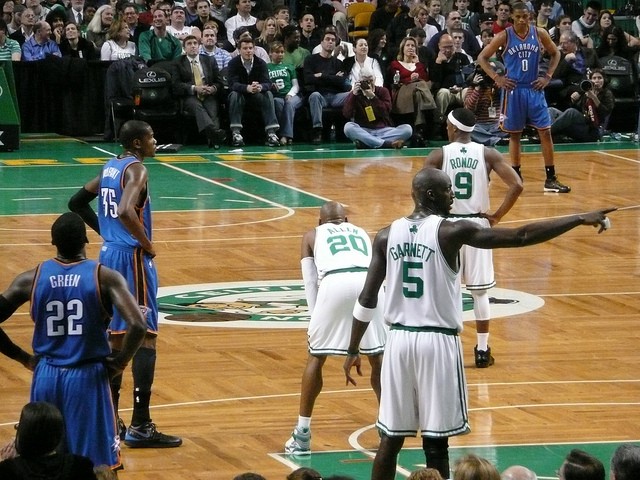
Usually, at the NBA trading deadline, there are a couple of minor trades here and there, Troy Murphy and Tim Thomas get thrown in to make the money work, and the league’s balance of power remains largely unchanged.
Not this year and certainly not in the Atlantic Division. Overnight, by trading a bunch of .500-caliber ballplayers and Timofey Mozgov, the Knicks made themselves a whole lot better with the addition of another superstar-and-a-half. The Celtics went in the opposite direction by trading their starting center for a much smaller guy who will be of zero help versus any team with a scoring center or power forward. Still, as far as the division goes, the Celtics have the crown sewn up, the Knicks will be trouble for first-round playoff opponents and the Sixers are better than the other two teams, both of which are terrible. No, seriously, that’s all I have.
The Celtics (42–15)
Here’s the thing: the Celtics championship window is closing. The combined ages of Kevin Garnett, Ray Allen and Paul Pierce is around 186. There is one, maybe two years after this when the present lineup will be able to walk, much less compete, against the conference’s big boys (the Heat, Magic and now, the Knicks). So the decision to trade their young starting center, Kendrick Perkins, for the talented but formerly-unable-to-hack-Boston wingman Jeff Green makes about as much sense as that Nets owner trading his only two good players for a point guard that will run for the hills in eighteen months.
The reason the Celtics have beaten the Heat this season is because they have size and discipline and a stout interior defense. Kendrick Perkins was a huge part of that. And, presumably, he and Rajon Rondo would continue to be a solid core long after the original Big Three are done playing.
But Danny Ainge decided that the team would be hard pressed to sign Perkins in the offseason and so he shipped him out. Big mistake. You show me a team that worries about next year and I’ll show you a team that isn’t winning squat this year. “Win now” should be written on every blackboard in every locker room. The Celtics were built to do so. They were firmly inside the Heat players’ heads. And overnight they’ve become a smaller team that is going to get run around and, occasionally, pushed around. No wonder KG was cursing up a storm when he heard the news.
New York Knicks (30–27)
The Knicks traded a lot of players for Carmelo Anthony and Chauncey Billups. But if you watched Sunday night’s win over the Miami Heat, you quickly realized that the Knicks have not had players with this much talent since the early ’70s. Wilson Chandler, Danilo Gallinari and Raymond Felton are not All-Stars. Maybe they will be at some point, but I wouldn’t bet on it. But Billups, Anthony and Stoudemire have been and will make for a dangerous playoff opponent. All three get to the line and make their free throws. Anthony especially is nearly impossible to defend. And they don’t call Chauncey Billups “Mr. Big Shot” for nothing. Still, after watching the three games since the trade, I have to admit: they still look way too small to win the East, but now that the Celtics have gifted them, one never knows.
Philadelphia Sixers (30–29)
They aren’t fun to watch. That much is obvious. But they do have very good players in Andre Iguodala and Elton Brand and a total of nine guys that play twenty minutes per night. Players like Jrue Holiday, Thaddeus Young and Louis Williams are promising and offer the team an ability to shuffle players in and out. Keeping everyone fresh. For what I don’t know. Their playoff run will be more like a hop. And done. The team probably couldn’t find a better teacher for the circumstance than fresh-faced Doug Collins who, miraculously, has them playing hard. Still, there isn’t enough firepower to beat the division’s top teams. And let’s not forget that they get to feast upon the twin corpses of the Nets and Raptors, which helps to pad their record. If the Sixers happen to make it to the playoffs — and the conference’s general softness indicates that they will — that is where the unmasking will truly begin.
New Jersey Nets (17–30)
Give team owner Mikhail Prokhorov credit: he took his shot, trading two studs, Derrick Favors and Devin Harris for an incredible player: point guard and malcontent Deron Williams. The problem is that Williams’ will be a free agent after the 2012 season. And the Nets, bereft of talent and with a screechy, control-freak of a coach in Avery Johnson, are about as attractive to free agents as Chris Christie in a Speedo. This season is all about “finishing strong” and next season will be about “showing progress.” But those are just words written in a souvenir program. With or without Williams, this team is terrible. And in 2013, when their starting point guard is either Steve Nash or Mike Bibby, their fans will have the misfortune of watching the newest Knick Williams torment them on a nightly basis. How does one say “oops” in Russian?
Toronto Raptors (16–42)
I have a lot of friends from Toronto. They all have glasses, sport short hair and smile a lot. They read books and are constantly out and about. And yet they couldn’t name three Raptors, the head coach or the GM. I can’t say that I blame them, either. The Raptors have only two players on their roster that average over 15 points per game (Andrea Bargnani and DeMar DeRozen) and a total of zero players that average over 7 boards). Chris Bosh was probably right to leave because even if he had stayed, they still would’ve been putrid. Not to mention, it’s Canada. Playing hoops in Canada is like playing rugby in Mexico. Fan support is so lax that if this team isn’t playing in Vegas or Anaheim in three years I will be shocked.
Tony Gervino is a New York City-based editor and writer obsessed with honing his bio to make him sound quirky. He can also be found here.
Are You A Diet Soda Junkie?
Now an addiction: diet soda. “Another distinguishing feature of substance dependence — whether it’s to caffeine, nicotine, or hard drugs like heroin — is the painful withdrawal symptoms that occur if a person tries to quit cold turkey. Although it’s difficult to pinpoint whether aspartame, caffeine, or some combination of ingredients is responsible, people who cut back on diet soda report symptoms such as headaches, nausea, and irritability…”
Juarez Isn't Even the Most Dangerous City in the Americas
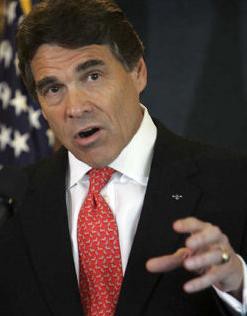
In defense of Texas Governor Rick Perry, who called Juarez “the most dangerous city in America,” it’s not like El Paso and Juarez aren’t deeply intertwined and immediately abutting — as you will recall from when the MEXICAN SPY DRONE landed on (BARELY) AMERICAN SOIL in El Paso. Though, in many ways, they have nothing in common! Contrary to what the right-wing border militia winguts say, America’s border cities often have an admirable crime rate. (Also, I would not agree that Juarez is the most dangerous city in the Americas, either. Have you been to Bogota and St. Louis recently?)
